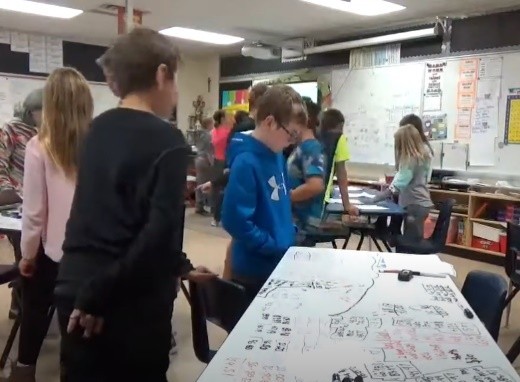"The way human beings learn has nothing to do with being kept quiet." - Ralph Peterson
How often is our voice (teacher voice) the dominant voice in the room? More often than we think, according to the research. What we know is that learning is a “social construct”—for all of us. We all learn best by being part of a community of learners. We know that students think more deeply and consolidate their reasoning by communicating their math thinking. In Reflections on Research in School Mathematics, Glanfield summarized the reasons that discussion must be centre stage in math classrooms. “Communication helps students organize and reflect on their own thinking. Furthermore, math in the real world does not happen in isolation, but rather through collaboration and co-operation. All authentic mathematical work includes an element of explanation and justification of reasoning, whether verbal or written. (Glanfield 2007).
A Gallery Walk allows students to examine others' work and have conversations around strategies.
Studies suggest we only truly understand something when we’ve had to verbalize it, and brain research has demonstrated that people learn best by collaborating with others. Both receptive and expressive forms of communication are beneficial to learners. The act of formulating dialogue around a mathematical topic forces students to collate the concepts logically. Giving students opportunities to converse about math concepts allows them to develop their mathematical vocabulary, and helps them construct meaning for themselves. Students benefit from hearing, evaluating, and analyzing others’ strategies. By reading and writing about, listening to and discussing mathematical ideas using both personal and formal mathematical language and symbols, students can create connections to their own ideas and prior knowledge.
Students need opportunities to read about, represent, view, write about, listen to, and discuss mathematical ideas using both personal and mathematical language and symbols. These opportunities allow students to create links among their own language, ideas, and prior knowledge, the formal language and symbols of mathematics, and new learnings.
We need to establish classroom norms that promote routine dialogue and debate about our mathematical thinking, and ensure that students’ mathematical communication is valued. Teachers can communicate by modeling their thinking out loud, which can be an effective instructional practice. By using tools such as word walls, glossaries, and online dictionaries, we can encourage students to use correct mathematical terminology. Students need opportunities to speak, read, and write about their mathematical ideas.
Download talking stems here Talking Stems Middle and High School
Fostering Communication in math class
Saskatchewan Ministry of Education, Renewed Math Curriculum (2009); Florence Glanfield, (2007). Building Capacity in Teaching and Learning. Reflections on Research in Mathematics. Pearson Education Canada; Elementary Mathematics Pedagogical Content Knowledge: Powerful Ideas for Teachers, by J.E. Schwartz, 2008 edition National Council of Teachers of Mathematics Hattie, J. (2017). Visible Learning for Mathematics. Corwin. Thousand Oaks, CA





